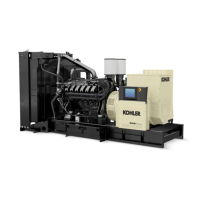What causes fuel filter restriction in a Kohler Portable Generator?
- AAndrew SmithAug 2, 2025
A fuel filter restriction can be caused by a dirty filter. Clean or replace the fuel filter.

What causes fuel filter restriction in a Kohler Portable Generator?
A fuel filter restriction can be caused by a dirty filter. Clean or replace the fuel filter.
What to do if my Kohler Portable Generator runs out of fuel?
If your Kohler Portable Generator runs out of fuel, add fuel to the tank and ensure the fuel valve is in the ON position.
How to fix engine overload on my Kohler Portable Generator?
To fix an engine overload on your Kohler Portable Generator, reduce the electrical load you're placing on the generator.
What to do if the coolant level is low in my Kohler Portable Generator?
If the coolant level is low, restore the coolant to the normal operating level.
How to fix an exhaust system leak on a Kohler Portable Generator?
If there's an exhaust system leak, inspect the exhaust system and replace any damaged or deteriorated components.
What to do if the exhaust system is not securely installed on my Kohler Portable Generator?
If the exhaust system is not securely installed, inspect the exhaust system and tighten any loose components.
What to do if the controller fuse is blown on my Kohler Portable Generator?
If the controller fuse is blown, check for battery power to the controller and replace the fuse.
| AC Output Voltage | 120V |
|---|---|
| Fuel Type | Gasoline |
| Starting Method | Recoil |
| Output Power | 800 W |
| Peak Power | 1000 W |
| Output Voltage | 120 V |
| Frequency | 60 Hz |
| Rated AC Output Power | 800 Watts |
| Max AC Output Power | 1000 Watts |
| Engine Type | 4-stroke OHV |
Procedures to prevent accidental starting and disable the generator set.
Hazards associated with battery acid, gases, and explosion risks.
Risks of flammable fuels, engine backfire, and exhaust fumes like carbon monoxide.
Dangers of electrical shock, injury from moving parts, and proper grounding practices.
Warnings about hot components, lifting safety, and testing live circuits.
Overview of essential safety precautions to follow during maintenance activities.
Detailed safety guidelines for handling batteries, including acid and gas hazards.
Safety warnings related to alternator maintenance, electrical shock, and short circuits.
Safety measures to follow when preparing the generator set for storage.
Lists associated manuals and documentation for the generator set.
Guidance on locating and recording generator set nameplate information.
Overview of how specifications are provided for generator sets and controllers.
Detailed technical specifications and key functionalities of the controller.
Information on how to connect external devices and systems to the controller.
Details on optional manual controls and compliance with NFPA standards.
Overview of controller parameters and base module inputs/outputs configuration.
Essential checks to perform before starting the generator set.
Procedures for generator set exercise and recommendations for cold weather.
Explanation of different operating modes like Auto, Manual, and Out of Service.
How the load shed feature removes non-critical loads based on generator output.
Guide to understanding the Human-Machine Interface screen structure and elements.
Procedures for operator login and viewing mechanical and electrical data.
How the controller logs and displays system events, faults, and alarms.
Accessing utility functions like reference, settings, and updates.
Overview of the controller's menu structure and access permissions.
Overview of maintenance practices and essential safety precautions.
Table outlining recommended maintenance intervals and actions for various systems.
Procedures for maintaining the diesel fuel system, including filters and fuel/water separators.
Instructions for oil changes, oil analysis, and managing the oil replenishment system.
Procedures for checking coolant levels, inspecting components, and draining/flushing the system.
Information on battery types, cleaning, charging, and safety precautions.
Guidelines for checking alternator installation, ventilation, bearings, and windings.
Steps for preparing the generator set for long-term storage and associated safety.
Overview of troubleshooting resources and general advice for diagnosing issues.
Guidance for diagnosing problems with generator set, controller, engine, and transfer switch.
A comprehensive chart listing common problems, probable causes, and recommended actions.
Information on available accessories and how to connect them to the generator set.
Details on Analog, Digital, and Thermocouple I/O modules and their specifications.
Information on the RSA III annunciator panel for remote monitoring and alerts.